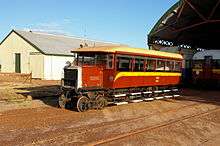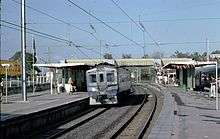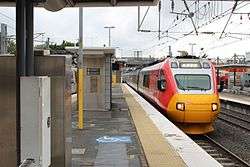Queensland Rail
|
| |
|
Tilt Train at Bowen Hills in September 2016 | |
| Industry | Railway operator |
|---|---|
| Founded | 31 July 1865 |
| Headquarters | Brisbane, Australia |
Area served | Queensland |
Key people | Neil Scales Acting CEO |
| Revenue | $1.92 billion (2015/16) |
| $820 million (2015/16) | |
| $165 million (2015/16) | |
Number of employees | 5,959 (June 2016) |
| Parent | Government of Queensland |
| Divisions |
Citytrain Traveltrain |
| Website |
queenslandrail |
Queensland Rail, also known as QR, is a railway operator in Queensland, Australia. Owned by the Queensland Government, Queensland Rail operates suburban and long-distance passenger services. It also owns and maintains approximately 8,000 kilometres of track in Queensland.
History

Beginnings
Queensland Railways was the first operator in the world to adopt narrow gauge (in this case 3 ft 6 in (1,067 mm)) for a main line,[1] and this remains the systemwide gauge within Queensland today.
The colony of Queensland separated from New South Wales in 1859, and the new government was keen to facilitate development and immigration. Improved transport to the fertile Darling Downs region situated west of Toowoomba was seen as a priority. As adequate river transport was already established between the capital Brisbane and the then separate settlement of Ipswich, the railway commenced from the latter locality and the initial section, built over relatively flat, easy country opened to Bigge's Camp, at the eastern base of the Little Liverpool Range, on 31 July 1865. Called the Main Line, the only significant engineering work on that section was a bridge over the Bremer River to North Ipswich.
Tunneling excavation through the Little Liverpool Range delayed the opening of the next section to Gatton by 10 months, but the line was opened to Toowoomba in 1867, the ascent of the Main Range being the reason for the adoption of narrow gauge.
Built by the Queensland government to the unusual (for the time) gauge of 3 ft 6 in (1,067 mm), the line largely followed the alignment surveyed by a private company, the Moreton Bay Tramway Company, which had proposed to build a 4 ft 8 1⁄2 in (1,435 mm) horse-drawn tramway but had been unable to raise funds to do so beyond an initial start on earthworks.
The adoption of narrow gauge was controversial at the time, and was largely predicated by the government's desire for the fastest possible construction timeframe at least cost.[2] This resulted in adoption of sharper curves and a lower axle load than was considered possible using standard gauge, and an assessment at the time put the cost of a narrow gauge line from Ipswich to Toowoomba at 25% of the cost of a standard gauge line. In a colony with a non-indigenous population of 30,000 when the decision was made, it is understandable.
The pattern of early Queensland railway development was focused upon providing transport from inland areas to ports at the lowest possible cost. Coastal shipping provided adequate connections between the coastal communities and so priority was given to building railways which would facilitate development and immigration to the interior of the colony. This resulted in 11 separate lines being constructed in isolation, rather than as extensions to a connected system.
- 1: Brisbane - Charleville, Warwick & Yandina
- 2: Cooroy - Gympie - Maryborough - Bundaberg
- 3: North Bundaberg - Mount Perry
- 4: Rockhampton - Longreach, Clermont & Springsure
- 5: North Rockhampton - Emu Park
- 6: Mackay - Eton & Mirani
- 7: Bowen - Guthalungra
- 8: Townsville - Hughenden
- 9: Cairns - Mareeba
- 10: Cooktown - Laura
- 11: Normanton - Croydon
In 1883 the Queensland government decided to connect Brisbane to Gladstone, and by 1900 to extend that line north to Rockhampton. In 1910 the most significant scheme to connect all remaining significant systems was made with the passing of the North Coast Railway Act. By the 1920s, all bar the Cooktown - Laura and Normanton - Croydon lines had been joined.
Queensland Rail went on to develop an extensive network of railways to facilitate the economic and social development of the state, totaling 10,500 km at its peak in 1932.

Changing transport patterns resulted in the closure of many development branch lines from 1948 onwards, but at the same time the main lines were upgraded to provide contemporary services, and from the 1970s an extensive network of new lines was developed, particularly to service export coal mines.
Electrification
Commencing in November 1979 the Brisbane suburban network was electrified.
In 1978, discussions were commenced on possible electrification of the Blackwater and Goonyella coal networks. This was due to an expected increase in coal traffic across the networks, ageing diesel-electric locomotive fleet and the increase in diesel fuel costs. By early 1983, a decision had been made to electrify the networks and by early 1984 contracts were already starting to be let for the new locomotives and other works for the project. The decision was made to electrify with the 25 kV AC railway electrification system as used on the Brisbane suburban network. This would allow future connection of the Brisbane network with the coal networks via the North Coast line.
The project was to be carried out in four stages:[3]
Stage 1: Electrification of the main line from Gladstone to Rockhampton, including parts of Rockhampton marshalling yard, then west to Blackwater and the coal mines in the area. This was a total of 720 kilometres (450 mi) of track.
Stage 2: Electrification of the coal lines south of Dalrymple Bay and Hay Point, then west through the Goonyella system, south-west to Blair Athol and south to Gregory – linking the Goonyella system to the Blackwater system. This was a total of 773 kilometres (480 mi) of track.
Stage 3: Electrification of the main western line from Burngrove to Emerald. This would allow electric freight from Rockhampton to Emerald.
Stage 4: Electrification of the line from Newlands coal mine to Collinsville and north-east to Abbott Point. This stage never went ahead. In 1986 it was decided to electrify the North Coast line between Brisbane and Gladstone instead and this became known as Stage 4.[4][5]
Interstate expansion
In September 1999 Queensland Rail was rebranded as QR.[6] In March 2002 Queensland Rail purchased Northern Rivers Railroad and rebranded it Interail, fulfilling a long held ambition of to expand beyond its state borders.[7][8]
In March 2003 Queensland Rail entered the Hunter Valley coal market when Interail commenced a contract from Duralie Colliery to Stratford Mine. Another coal contract was won in late 2003 for the haulage of coal from Newstan Colliery, Fassifern to Vales Point Power Station. In 2004 Interail began running Brisbane to Melbourne and Sydney to Melbourne intermodal services. In June 2005 Queensland Rail acquired the CRT Group.[9]
In June 2006 the Western Australian business of the Australian Railroad Group was purchased.[10][11][12]
Privatisation
In June 2009 the Queensland Government announced the privatisation of Queensland Rail's freight business.[13][14] This resulted in Queensland Rail's freight assets being transferred to QR National (now Aurizon) from 1 July 2010.
Redcliffe Peninsula railway line
In October 2016 the opening of a new rail line to the Redcliffe Peninsula resulted in the failure of the rail network. Hundreds of services were cancelled without notice due to a lack of trained drivers and staff. Passengers experienced extended delays and promised services which did not arrive.
Several weeks after the service interruptions, Queensland Rail CEO Helen Gluer announced her resignation along with chairman Michael Klug.[15]
It was announced on 27 October 2016, that the director-general of the Department of Transport and Main Roads, Neil Scales, would replace Helen Gluer.
Commissioners
The Commissioners of the Queensland Railways included:[16]
- 1864—1885: Arthur Orpen Herbert
- 1885—1889: Francis Curnow
- 1889—1894: A. Johnston
- 1889—1896: John Mathieson
- 1889—1902: R. J. Gray
- 1902—1911: James Forsyth Thallon
- 1911: T. M. King
- 1911—1918: Barnard Charles Evans
- 1918— : J. W. Davidson
Services
City network
Queensland Rail, in partnership with TransLink, provides Urban and Interurban rail and bus services throughout South East Queensland. These rail services operate on eleven rail lines including Beenleigh, Caboolture, Cleveland, Doomben, Exhibition, Ferny Grove, Gold Coast, Ipswich/Rosewood, Redcliffe Peninsula, Shorncliffe and Sunshine Coast lines. Queensland Rail provides train services on these lines with its rolling stock of electric multiple units, which includes the Electric Multiple Units (EMU), the Suburban Multiple Units (SMU), the Interurban Multiple Units (IMU) and the InterCity Express (ICE).
Due to low patronage, lines such as the Pinkenba line have been closed and replaced by bus services known as a RailBus. During some times of the day trains on the Sunshine Coast line and Doomben line are also replaced by a RailBus.
Long-distance trains
Queensland Rail operate these long-range passenger rail services:[17]
- Electric Tilt Train: Brisbane to Rockhampton
- Spirit of Queensland Diesel Tilt Train: Brisbane to Cairns
- Spirit of the Outback: Brisbane to Longreach
- The Inlander: Townsville to Mount Isa
- The Westlander: Brisbane to Charleville
Annual patronage for these services in 2011/12 was 795,000.[18] In 2007/08, the subsidy for the Brisbane-Cairns route was $130 million, or $900 per passenger. In 2001/02 it was $270 million.[19][20]
Queensland Rail also operate these tourist trains:[17]
- Kuranda Scenic Railway: Cairns railway station to Kuranda
- The Gulflander Normanton to Croydon
- The Savannahlander: Cairns to Forsayth
Fleet
| Class | Image | Type | Top speed (km/h) | Built | Number | Routes operated | Notes |
| City network fleet | |||||||
|---|---|---|---|---|---|---|---|
| EMU |  |
Electric multiple unit | 100 | 1979–1987 | 87 | City network | All remaining 87 EMUs are planned to be progressively retired from 2017. The first units removed will be EMUs 60-79, then the rest of the fleet with the last one removed from service in December 2018, as they will be replaced with New Generation Rollingstock |
| SMU200 |  |
Electric multiple unit | 100 | 1994–1995 | 12 | City network | Queensland Rail may be removing some or all SMU200 series trains at the same time as the EMUs, due to unreliability problems. Currently SMU203 is not in service. |
| SMU220 |  |
Electric multiple unit | 100 | 1999–2001 | 30 | City network | |
| SMU260 |  |
Electric multiple unit | 130 | 2008–2011 | 35 | City network | |
| ICE |  |
Electric multiple unit | 120 | 1988–1989 | 8 | Sunshine Coast line | Expected to be retired from 2017 |
| IMU100 |  |
Electric multiple unit | 140 | 1996–1997 | 10 | City network | |
| IMU120 |  |
Electric multiple unit | 140 | 2001–2002 | 4 | City network | |
| IMU160 | Electric multiple unit | 130 | 2004–2011 | 28 | City network | ||
| NGR | Not yet in service | Electric multiple unit | 140 | 2015-2018 | 5 | City network | Not yet in service. 75 on order |
| Locomotive fleet[1] | |||||||
| 1720 class | Diesel locomotive | 100 | 1966–1970 | 15 | Kuranda Scenic Railway, Traveltrain services and infrastructure trains | ||
| 2150 class | Diesel locomotive | 100 | 1966–1970 | 6 | Traveltrain services and infrastructure trains | ||
| 2400 class | Diesel locomotive | 100 | 1966–1970 | 5 | Traveltrain services and infrastructure trains | ||
| 2470 class | Diesel locomotive | 100 | 1980–1983 | 5 | Traveltrain services and infrastructure trains | ||
| DL class |  |
Diesel locomotive | 50 | 1961 | 1 | DL4 backup for the Gulflander. | |
| Traveltrain fleet | |||||||
| Electric Tilt Train | Tilting electric multiple unit | 160 | 1997 | 2 | North Coast line | ||
| Diesel Tilt Train | Tilting diesel multiple unit | 160 | 2003, 2014 | 3 | North Coast line | ||
| Tourist train fleet | |||||||
| 45 hp rail motor |  |
Railmotor | 40 | 1931 | 1 | Based at Normanton, used for charters | |
| 102 hp rail motor |  |
Railmotor | 50 | 1950 | 1 | Gulflander | |
| 1800 class |  |
Railmotor (trailers) | 50 | 1952–1954 | 2 | Gulflander | |
| 2000 class |  |
Railmotor | 80 | 1956–1971 | 3 | Savannahlander | Operated by private contractor |
| Heritage fleet | |||||||
| A10 class | Steam locomotive | 40 | 1865–1866 | 1 | No 6 operational, Australia's oldest operational steam locomotive. Usually placed on display at the Workshops Rail Museum when not required for special trains. | ||
| PB15 class | Steam locomotive | 65 | 1899–1926 | 1 | 732 being overhauled | ||
| AC16 class | Steam locomotive | 80 | 1943 | 1 | 221A operational. (USATC S118 Class) | ||
| C17 class | Steam locomotive | 80 | 1920–1953 | 2 | 974 operational, 1000 being restored to working order | ||
| DD17 class | Steam locomotive | 80 | 1948–1952 | 1 | 1051 restored to working order, currently under heavy overhaul | ||
| BB18¼ class |  |
Steam locomotive | 80 | 1950–1958 | 2 | 1079 &1089 operational | |
| Beyer-Garratt | Steam locomotive | 80 | 1950–1951 | 1 | 1009 stored pending overhaul | ||
| DL class | Diesel locomotive | 50 | 1939 | 1 | On display at the Workshops Rail Museum | ||
| DH class | Diesel locomotive | 50 | 1966 | 2 | DH2 and DH71 stored | ||
| 1150 class | Diesel locomotive | 80 | 1952 | 1 | 1159 stored pending restoration | ||
| 1170 class |  |
Diesel locomotive | 80 | 1956 | 1 | 1170 stored pending restoration | |
| 1250 class | Diesel locomotive | 80 | 1959 | 1 | 1262 on display at Workshops Rail Museum | ||
| 1270 class | Diesel locomotive | 80 | 1964 | 2 | 1270 stored pending restoration, 1281 on display at Workshops Rail Museum | ||
| 1400 class | Diesel locomotive | 80 | 1955 | 1 | 1407 stored pending restoration | ||
| 1450 class | Diesel locomotive | 80 | 1957 | 3 | 1450, 1455 & 1459 stored pending restoration | ||
| 1460 class | Diesel locomotive | 80 | 1964 | 1 | 1461 stored pending restoration | ||
| 1600 class | Diesel locomotive | 80 | 1962 | 1 | 1603 stored pending restoration | ||
| 1620 class | Diesel locomotive | 80 | 1967 | 1 | 1620 operational | ||
| SX carriages | Passenger car | 80 | 1961-1962 | 7 | Formed into one 7-car set | ||
| 1900 class |  |
Railmotor | 80 | 1956 | 1 | 1901 operational, also used as a track inspection vehicle | |
| 2000 class |  |
Railmotor | 80 | 1956–1971 | 6 | 2034, 2036 & 2057 operational, also used as inspection vehicles. 2005, 2024 & 2031 stored | |
| Special cars | |||||||
| Vice-Regal Car | 80 | 1903 | 1 | Car 445 is a special saloon retained for use by the Governor of Queensland and is still considered a working item of rollingstock in the QR fleet, however it is on permanent loan to Workshops Rail Museum.[21] | |||
- 1 This table only includes locomotives owned by Queensland Rail. QR also hires locomotives from Aurizon as required.
See also
References
- ↑ Kerr J 'Triumph of Narrow Gauge', Boolarong Publications 1990
- ↑ "Parlament". The Brisbane Courier. National Library of Australia. 18 May 1864. p. 2. Retrieved 4 March 2014.
- ↑ Queensland Rail (August 1984). "Fact Sheet No.1 August 1984 Everything you should know about Australia's biggest railway project" (1): 1.
- ↑ RW Dunning & AM Drake (Circ 1985). "Mainline Electrification" (1): 3. Check date values in:
|date=(help) - ↑ Queensland Rail (February 1986). "Fact Sheet No. 9 Main Line Electrification Project Special Edition" (1): 1.
- ↑ "Queensland Rail Becomes QR and Looks Beyond its Borders" Railway Digest November 1999 page 9
- ↑ "QR moves into NSW with Northern Rivers Railroad buy" Archived 6 February 2015 at the Wayback Machine. Rail Express 12 March 2002
- ↑ "QR National push" WorldCargo News March 2002
- ↑ Queensland Rail sorts logistics for acquisition The Age 25 June 2005
- ↑ Sale of Australian Railroad Group Wesfarmers 14 February 2006
- ↑ ARG on board Queensland Rail The Age 31 March 2006
- ↑ QR closes national rail freight deal QR National 2 June 2006
- ↑ Queensland asset sales to reap $15 billion Brisbane Times 2 June 2009
- ↑ Premier announces QR Privatisation Plan Railway Gazette International]] 4 June 2009
- ↑ "Queensland Rail boss, chairman resign over driver crisis". ABC News. 2016-10-27. Retrieved 2016-10-27.
- ↑ "RAILWAY COMMISSIONERS.". The Brisbane Courier (Qld. : 1864 - 1933). Qld.: National Library of Australia. 28 July 1924. p. 37 Supplement: Queensland's Centenary. Retrieved 22 June 2015.
- 1 2 Home Queensland Rail Travel
- ↑ Annual Report June 2012 Archived 18 May 2013 at the Wayback Machine. Queensland Rail
- ↑ Wardill, Steven (26 December 2008). "$130m subsidy for Brisbane-Cairns Traveltrain". The Courier-Mail.
- ↑ Patrick Lion (28 December 2008). "$900-a-ticket subsidy for tilt train to remain, says Anna Bligh". The Courier-Mail.
- ↑ "The Vice-Regal Car (Special car 445)" (PDF). Queensland Museum.
External links
 Media related to Queensland Rail at Wikimedia Commons
Media related to Queensland Rail at Wikimedia Commons- Queensland Rail
- TransLink
- Works by Queensland Railways at LibriVox (public domain audiobooks)


